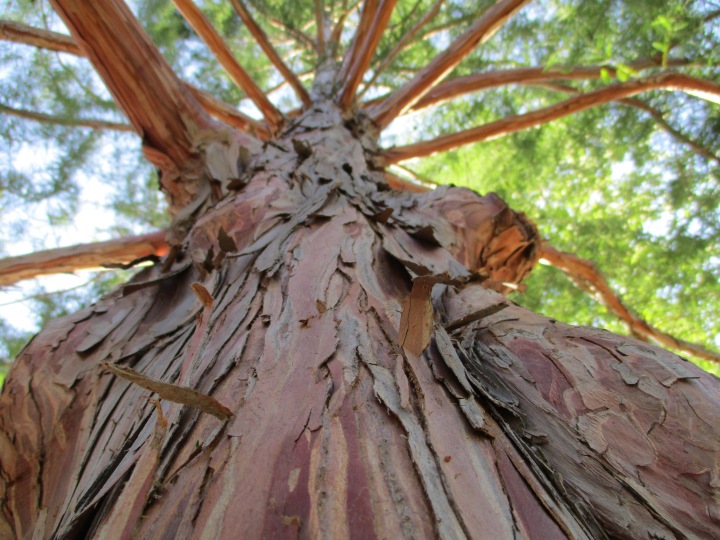 Lemon eucalyptus, ‘Marina’ madrone, cork oak and all sorts of melaleuca trees are known more for their interesting bark than for their foliage or flowers. It helps that their distinctive trunks and branch structures are ideal for displaying their unique bark. Color and texture of bark is remarkably variable, and tends to get noticed more in winter while blooms and foliage are lacking.
Lemon eucalyptus, ‘Marina’ madrone, cork oak and all sorts of melaleuca trees are known more for their interesting bark than for their foliage or flowers. It helps that their distinctive trunks and branch structures are ideal for displaying their unique bark. Color and texture of bark is remarkably variable, and tends to get noticed more in winter while blooms and foliage are lacking.
Bark of sycamores, birches, elms and crape myrtles that had been so handsome throughout the year is more visible now that it is not partially obscured or shaded by the deciduous foliage that is associated with it. Trunks and limbs of European white and Jacquemontii birches are strikingly white. ‘Natchez’ crape myrtle has distinctively blotched bark, (although the white flowers are pale.)
Because of their other assets, English walnuts, figs and saucer magnolias are not often grown for their bark. Nonetheless, their pale gray bark shows off their stocky bare branch structure nicely, especially in front of an evergreen backdrop of redwoods or pines. The smooth metallic gray bark of European beech is much more subdued, but is what makes big old trees so distinguished.
A few deciduous trees and shrubs get more colorful as winter weather gets cooler. Instead of white or pale gray, their bark turns brighter yellow, orange or red. Some plants, like sticks-of-fire, do not need much cool weather to develop good color. Others get more colorful in colder climates, and contrast spectacularly to a snowy landscape. Locally, they should be well exposed to chill.
As the name suggests, the coral bark Japanese maple (‘Sango Kaku’) develops pinkish orange bark. It can get ruddier in colder climates, but may get yellowish here. Unlike other Japanese maples that get pruned to display their delicate foliage and branch structure, the coral bark Japanese maple sometimes gets pruned more aggressively to promote more colorful twiggy growth.
Osier dogwood is a shrubby dogwood that lacks colorful bloom, but compensates with ruddy brown, brownish orange or pale yellow bark in winter. (Dogwood bark . . . There is a pun there somewhere.) Because it lacks colorful bloom, it can be pruned aggressively after winter. Older canes that do not color as well can be pruned to the ground as they get replaced by new canes.
And Osier dogwood branches, collected from a Minnesota ditch in 2011, are still nice and red in their floor vase at my home.
LikeLiked by 1 person
Birch limbs have been popular for that sort of thing recently. When I must cut down one of the dead birch trees here. People stop and take some of the branches.
LikeLike
Brilliant. Thank you as always and I’m trying to come up with, unsuccessfully, a suitable pun for Dogwood bark. A tree cutting service brings us wood, which we mostly use as fire wood and we are often finding unusual woods with wonderful looking bark. Most often too we really don’t know what it is.
LikeLike
Dogwood ‘bark’? Is it smooth or ruff?
LikeLike
SNORT!
LikeLike
?
LikeLike
So which tree are you showing up above? It looks like one I found in the woods that I assumed was a Shagbark Hickory.
LikeLiked by 1 person
It is a bald cypress, which is rare in our region.
LikeLike
Love this perspective!
LikeLiked by 1 person
It was the only perspective from where I was at the moment. I could have gotten a better picture from a distance, but the tree was not much to look at.
LikeLiked by 1 person
I find bark to be very photogenic. Love all our various gum tree barks
LikeLiked by 1 person
Oh of course! The lemon gum that is somewhat popular in the Santa Barbara region and farther south is uncommon here. There seem to be many of them in Santa Barabara, and again in Ventura! (Santa Barbara and Ventura are in Southern California.) Those gum trees in the pictures of your travels were so fascinating because they were so sculptural and ‘artistic’ as if they were showing off for an audience. They seem so common and normal there.
LikeLiked by 1 person
Sculptural and artistic, good words to describe them
LikeLiked by 1 person
When I saw Joshua trees for the first time, the were illuminated from behind by the distant lights of Lancaster. I referred to them as a disco trees, and the name stuck.
LikeLiked by 1 person
Only seen photos of Joshua trees, they look so unusual
LikeLiked by 1 person
Oh, they really are weird. If old mature trees suddenly get more water than they are accustomed to (as if the area adjacent to them gets landscaped), they grow much faster and get very thick. They eventually drop limbs because they get heavier than they can support.
LikeLiked by 1 person